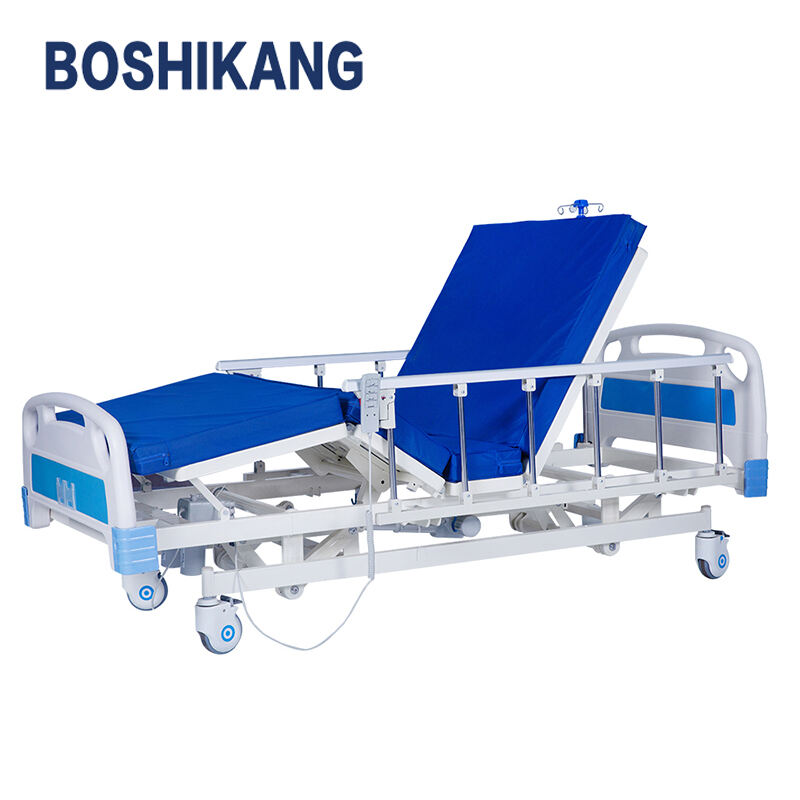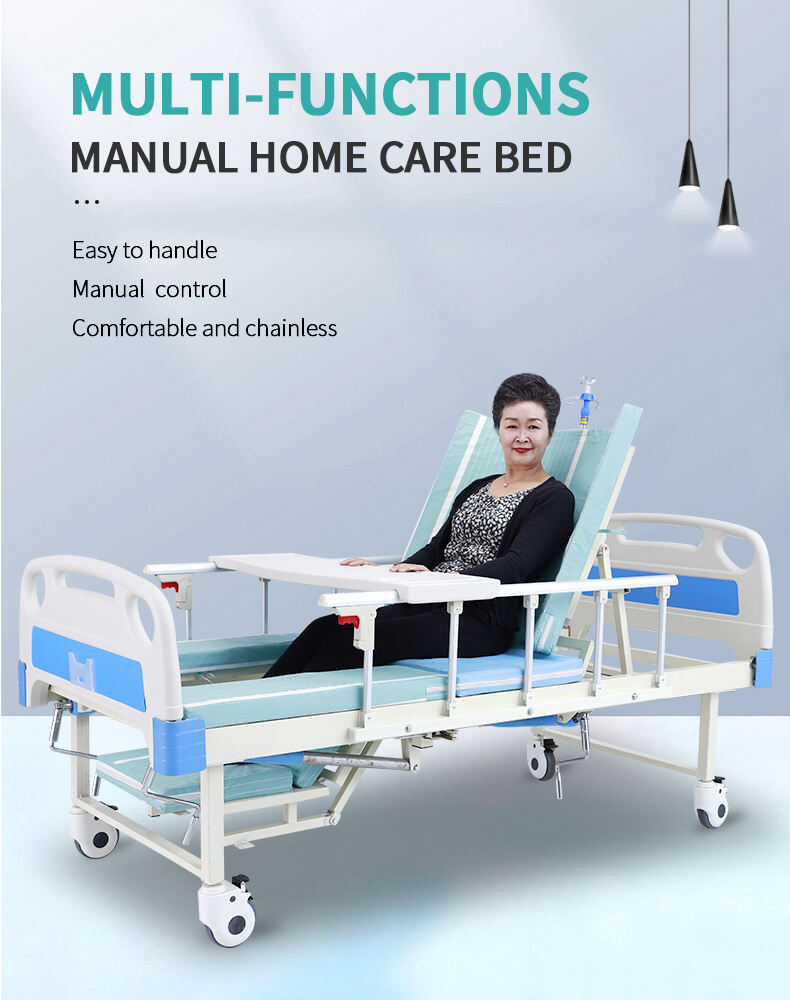Healthcare facilities worldwide recognize that patient comfort directly impacts recovery outcomes and overall treatment success. Modern healthcare environments demand equipment that not only meets clinical requirements but also prioritizes patient well-being and comfort. Advanced medical beds have emerged as fundamental components in creating healing environments that support both patient recovery and caregiver efficiency. These sophisticated pieces of equipment integrate cutting-edge technology with ergonomic design principles to deliver superior comfort and therapeutic benefits. The evolution of medical beds reflects the healthcare industry's commitment to patient-centered care and evidence-based healing practices.

Advanced Positioning Technology for Enhanced Comfort
Multi-Zone Adjustment Capabilities
Contemporary medical beds feature sophisticated positioning systems that allow precise adjustment of multiple bed zones simultaneously. These systems enable healthcare providers to customize patient positioning for optimal comfort and therapeutic positioning. The head section can be elevated to various angles to improve breathing, reduce reflux, and enhance patient communication during medical consultations. Knee and foot sections adjust independently, providing optimal circulation support and pressure redistribution. Advanced models incorporate memory foam and pressure-sensitive surfaces that automatically adapt to patient body contours.
The integration of silent motor systems ensures that positional adjustments occur smoothly without disturbing patient rest or creating noise in healthcare environments. Precision control mechanisms allow for micro-adjustments that accommodate specific medical conditions and individual patient preferences. These positioning capabilities prove particularly beneficial for patients with respiratory conditions, cardiac issues, or mobility limitations who require specialized positioning for optimal recovery.
Ergonomic Support Systems
Modern medical bed designs incorporate advanced ergonomic principles that support natural body alignment and reduce pressure points. The bed surface contours adapt to individual body shapes, distributing weight evenly across the entire sleeping surface. This technology significantly reduces the risk of pressure ulcers and promotes better circulation throughout extended bed rest periods. Specialized foam compositions and gel-infused materials enhance comfort while maintaining proper spinal alignment.
Integrated side rail systems provide secure support while maintaining patient independence and dignity. These rails feature soft-touch surfaces and intuitive controls that patients can easily operate without assistance. The ergonomic design extends to all patient contact surfaces, ensuring that every aspect of the bed contributes to overall comfort and healing. Temperature-regulating materials help maintain optimal body temperature, preventing overheating or chilling that could disrupt rest and recovery.
Smart Control Systems and Patient Empowerment
Intuitive User Interfaces
Advanced medical beds incorporate user-friendly control interfaces that empower patients to make adjustments independently. Touch-sensitive control panels feature large, clearly labeled buttons that respond to light pressure, making them accessible for patients with limited mobility or strength. Voice-activated controls represent the latest innovation, allowing patients to adjust positioning through simple verbal commands. These systems reduce dependency on nursing staff for basic comfort adjustments.
Wireless remote controls provide patients with convenient access to bed functions from any position. The controls feature illuminated displays for easy visibility in low-light conditions, ensuring patient safety during nighttime adjustments. Preset positioning options allow patients to quickly return to preferred positions for sleeping, dining, or medical procedures. Emergency call integration ensures that patients can quickly summon assistance when needed.
Automated Comfort Features
Intelligent medical beds incorporate automated systems that monitor patient movement and adjust positioning accordingly. Motion sensors detect when patients attempt to change positions and provide gentle assistance through motorized adjustments. These systems learn individual patient preferences over time, creating personalized comfort profiles that optimize rest and recovery. Automated massage functions provide therapeutic benefits that promote circulation and reduce muscle tension.
Sleep monitoring capabilities track patient rest patterns and automatically adjust environmental factors to promote better sleep quality. Integrated lighting systems provide gentle illumination for nighttime navigation while minimizing sleep disruption. Temperature control systems maintain optimal sleeping conditions throughout the night, automatically adjusting based on patient preferences and medical requirements. These automated features create a more comfortable and supportive healing environment.
Pressure Relief and Circulation Support
Advanced Mattress Technologies
State-of-the-art medical beds utilize sophisticated mattress systems designed specifically for pressure relief and circulation enhancement. Multi-zone pressure mapping technology continuously monitors patient contact points and automatically redistributes pressure to prevent tissue breakdown. Alternating pressure systems create dynamic surface changes that promote blood flow and prevent stagnation. Memory foam compositions conform to body contours while maintaining structural support.
Air-filled cell systems provide customizable firmness levels that adapt to individual patient needs and medical conditions. These systems can be programmed to provide firmer support for patient transfers and softer surfaces for extended rest periods. Integrated cooling systems prevent heat buildup that could contribute to discomfort or skin irritation. The combination of these technologies creates an optimal sleeping surface that supports both comfort and therapeutic outcomes.
Enhanced Blood Flow Promotion
Medical beds feature specialized positioning capabilities that promote healthy circulation throughout the body. Leg elevation systems improve venous return and reduce swelling in the lower extremities. Trendelenburg positioning supports patients with circulatory conditions by optimizing blood flow patterns. Gradual position changes prevent sudden pressure shifts that could cause discomfort or circulation problems.
Integrated compression therapy systems provide gentle, rhythmic pressure that stimulates circulation and prevents blood clots. These systems work in conjunction with positioning features to create comprehensive circulation support. The beds also incorporate features that prevent dependent edema and support lymphatic drainage. Regular automated position changes ensure that patients maintain healthy circulation even during extended periods of bed rest.
Safety Features and Fall Prevention
Comprehensive Safety Systems
Modern medical beds incorporate multiple safety features designed to prevent falls and protect patients during recovery. Low-height positioning capabilities minimize fall risk by reducing the distance to the floor when patients exit the bed. Automatic brake systems engage when patients attempt to leave the bed, providing stable support during transfers. Motion sensors detect patient movement patterns and alert caregivers to potential fall risks.
Soft-close mechanisms prevent accidental injury from moving bed components. All motorized functions include safety stops that prevent over-extension or compression. Emergency battery backup systems ensure that safety features remain operational during power outages. These comprehensive safety measures create a secure environment that supports patient independence while minimizing injury risks.
Caregiver Assistance Features
Advanced medical beds include features specifically designed to support healthcare providers in delivering safe, efficient care. Central locking systems allow caregivers to secure all bed wheels simultaneously, ensuring stability during patient care activities. Height adjustment capabilities position the bed at optimal working heights for different care procedures, reducing caregiver strain and improving patient safety.
Integrated patient monitoring systems provide real-time information about patient position, movement, and vital signs. These systems alert caregivers to changes in patient condition or potential safety concerns. Bedside control panels give healthcare providers immediate access to all bed functions without requiring patient cooperation. These features enhance both caregiver efficiency and patient safety outcomes.
Integration with Healthcare Technology
Electronic Health Record Connectivity
Contemporary medical beds seamlessly integrate with hospital information systems and electronic health records. This connectivity allows automatic documentation of patient positioning, sleep patterns, and comfort preferences. Data collection capabilities provide valuable insights into patient recovery patterns and treatment effectiveness. Healthcare providers can access comprehensive patient comfort data to optimize treatment plans and improve outcomes.
Real-time monitoring capabilities track patient vital signs and movement patterns, providing continuous assessment of patient condition. This information integrates directly into hospital workflow systems, reducing documentation burden on nursing staff. Automated alerts notify healthcare providers of significant changes in patient status or comfort levels. The integration supports evidence-based care decisions and improves overall treatment coordination.
Telemedicine and Remote Monitoring
Advanced medical beds support telemedicine initiatives through integrated communication systems and remote monitoring capabilities. Patients can participate in virtual consultations from the comfort of their beds, with positioning systems automatically adjusting for optimal communication. Remote monitoring allows healthcare providers to track patient progress and comfort levels from any location.
Cloud-based data storage ensures that patient comfort preferences and positioning requirements are accessible across different healthcare facilities. This continuity of care improves patient satisfaction and supports consistent comfort standards regardless of location. Remote diagnostic capabilities enable healthcare providers to assess bed function and patient comfort without physical presence, improving efficiency and reducing costs.
FAQ
How do electric medical beds improve patient recovery times
Electric medical beds significantly accelerate patient recovery by providing optimal positioning that supports natural healing processes. The ability to adjust head and leg elevation improves circulation, reduces swelling, and promotes better breathing patterns. Patients experience less pain and discomfort when positioned correctly, leading to better sleep quality and faster tissue repair. Studies show that patients using advanced positioning systems have shorter hospital stays and improved satisfaction scores compared to those using standard beds.
What safety features should patients and families look for in medical beds
Essential safety features include low-height positioning to minimize fall risk, automatic brake systems that engage during patient transfers, and soft-close mechanisms that prevent injury from moving parts. Look for beds with motion sensors that alert caregivers to patient movement, emergency call systems integrated into bed controls, and battery backup for critical functions. Side rails should feature intuitive controls and secure locking mechanisms while maintaining patient dignity and independence.
How do modern medical beds support different medical conditions
Medical beds adapt to various conditions through specialized positioning and support features. Cardiac patients benefit from elevated head positioning that reduces heart workload, while respiratory patients receive improved breathing support through optimal chest and airway positioning. Patients with circulation issues benefit from leg elevation and pressure redistribution systems. The beds accommodate wound care requirements through precise positioning that minimizes pressure on healing tissues while maintaining patient comfort.
What makes advanced medical beds cost-effective for healthcare facilities
Advanced medical beds reduce long-term costs through improved patient outcomes, reduced complications, and decreased length of stay. The prevention of pressure ulcers alone saves thousands of dollars per patient while automated features reduce nursing workload and improve staff efficiency. Better patient satisfaction scores improve hospital ratings and reimbursement rates. The durability and reliability of advanced systems reduce maintenance costs and equipment replacement needs, providing excellent return on investment for healthcare facilities.


